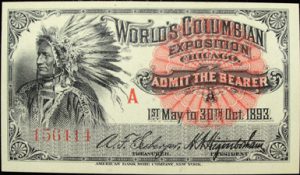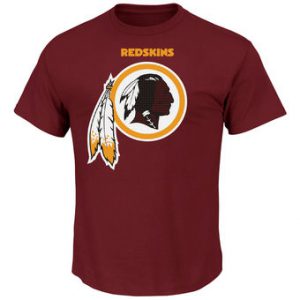The World’s Columbian Exposition, a fair in Chicago in 1893, celebrated 400 years since Columbus’ “discovery” of the Americas, but it was funded by colonialist powers in order to demonstrate human progress (Rinehart, 2012, 404). The Exposition endorsed racialized eugenics, contrasting a modern White City with the traditional Midway Plaisance, which was filled with ethnic villages (Fine-Dare, 2002, p. 22). Even though many people today recognize that this Exposition showed a backwards view of Indians, it is relevant because Americans have still not reconciled their notions of the Vanishing Indian with reality. Just as in 1893, the public continues to enjoy learning about Native Americans as an exotic, uncivilized, and long-gone race through sports.
During the World’s Columbian Exposition, Midway Plaisance stereotyped Native Americans as savages in order to amuse white tourists. Kathleen S. Fine-Dare (2002) provides an extremely upsetting advertisement of the event. It depicts two Native Americans with the caption, “These two… may never have scalped, nor built a fire around a prisoner, or flayed an enemy alive, but that does not signify that they would not do it if they had the chance” (p. 28). These types of advertisements of the event played into the stereotype that all Native Americans were aggressive savages (Rinehart, 2012, p. 419). It allowed the Exposition to neatly compare White City, the “pinnacle of civilization,” with Indians in the Midway Plaisance, who were portrayed as static, distorting the concept of evolution (Fine-Dare, 2002, 30). In reality, it displayed how little views had progressed about Native Americans since explorers met them in the late 1400s and early 1500s.

The American public continues to exotify Native Americans culture for public consumption. One of the most prominent examples is the Washington Redsk*ns. The team profits off of the derogatory caricatures of Native Americans. This legacy of colonialism is shameful. Some compare the pictures to using black-face or images of the Jews during the Holocaust (Woodrow Cox, 2016). According to the National Congress of American Indian, the name of the Washington Redsk*ns, specifically, ignores a long history in which Native Americans were killed and sold as commodities for their skins (National Congress of American Indians, 2013, p. 10). The stereotypes and negative views that were seen in the World’s Columbian Exposition have never died. Americans are still attached to stereotypes of Native Americans as uncivilized and barbaric.

Fine-Dare (2002) reminds us that this history is relevant because there is a “cultural legacy of mourning” (p. 51). In many ways, the same racial motifs are disseminated by the media in 2017. These reinforce systems of oppression against Indians, who still exist in the US today. Although the US no longer holds the World’s Columbian Exposition, it is essential that citizens learn about it. Current conversations of Indians continue to only entertain, not educate, the public about different cultures.
For more on racism at the World’s Columbian Exposition, see The Reason Why the Colored American Is Not in the World’s Columbian Exposition, by Ida B. Wells: http://digital.library.upenn.edu/women/wells/exposition/exposition.html
Works Cited
Fine-Dare, K. S. (2002). Grave Injustice: The American Indian Repatriation Movement and NAGPRA. University of Nebraska Press.
National Congress of American Indians (2013). Ending the Legacy of Racism in Sports & the Era of Harmful “Indian” Sports Mascots. Retrieved from http://www.ncai.org/resources/ncai-publications/Ending_the_Legacy_of_Racism.pdf.
Rinehart, M. (2012). To Hell With the Wigs!: Native American Representation and Resistance at the World’s Columbian Exposition. American Indian Quarterly, 36, 4.
Woodrow Cox, J. (2016, August 9). Cleveland’s Chief Wahoo: Why the Most Offensive Image in Sports Has Yet to Die. Washington Post. Retrieved from https://www.washingtonpost.com/local/clevelands-chief-wahoo-why-the-most-offensive-image-in-sports-has-yet-to-die/2016/08/09/245156c6-58e6-11e6-9aee-8075993d73a2_story.html?utm_term=.9f92282a8a0a.
